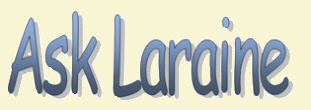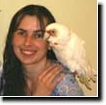How to Handle Your Birds
Kristen Reeves, Meadowlark Farms Avian Supply, Inc.
One of the many questions I'm repeatedly asked is "how" to handle and/or hold the birds for inspection, clipping nails, or any other time we may need to handle them. In this episode, I've described how I handle MY birds, and what I've found to give me the most control with even the most skittish or squirmy of birds.
First, take a peek at your hands...
Before capturing the bird, practice a little bit with the positioning of your hand and fingers.
Notice how I've made a modified "ok" sign with my fingers and hand. The free fingers will wrap around the bird's body as I hold it, while the first and second finger will hold the head immobilized.
When your first and second finger are together at the tips, with some practice you'll be able to flex your fingers open and closed. When the bird is in hand, this is will be your main mode of immobilization.
Once you've practiced with your hand and fingers, capture the bird you wish to inspect. Use our "roll method" (see video) to transfer the bird from one hand to the other and/or adjust the bird within your hand. Secure the bird's head between your first and second finger, loosely holding on, but never letting your first and second finger part at the tips. I'm right-handed, so I tend to roll transfer the bird into my left hand to leave my right hand free to write notes or move wings, feathers, feet, etc. out of the way of my view.
Top view of the bird in my hand with his head between my first and second fingers.
Under view. Notice the bird's body is flat against the palm of my hand with his head secured between my fingers. This technically leaves my thumb, ring and pinky fingers free to manipulate the bird or hold parts out for inspection.
Once you have a good hold on the bird with his head secure, you can then manipulate him to inspect his feathers, belly, skin tone, nostrils, feet...anything you need to check!
With his head secure, I can then use my thumb and just the tip of my first finger to hold his foot and inspect or clip his nails.
I use my free hand to pull the wing out, then secure it with the fingers securing the bird's head. A flighty or rarely handled bird may be wiggly, so you may need to adjust your hold a bit to prevent his escape.
Adjust your fingers as necessary to control the bird while you inspect the belly.
Once you are certain you have a good handle on the bird, you can then experiment to see the easiest way for YOU to inspect the head. Here, I've raised my first finger to keep his head in place and am now using my thumb and third finger to hold it in place.
I can then use all of the fingers holding the bird's head to manipulate the head for inspection.
Using a partial "roll method", I then turn the bird over to view his back and tail feathers. Notice I'm still holding his head between my first two fingers.
And finally, if the bird remains relatively calm, you can experiment by releasing a few of your fingers and positioning the bird in your hand to see most of the bird without your fingers in the way. Most of my birds are so tame that I really don't need much restraint to keep them still. In fact, mine are so used to being handled here that they rarely even fidget. But it takes time to get your birds used to you if you don't handle them often, so don't take any chances if they aren't this calm! Hang on tight until you are certain you can release those other fingers without the bird escaping!
If your birds are very calm like mine, you'll be able to hold them without much restraint. ~k





